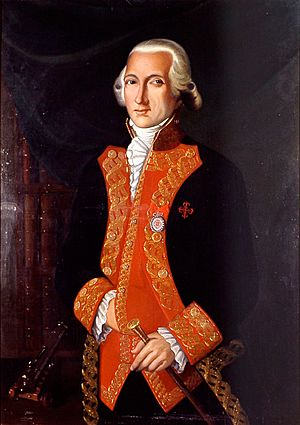Juan de Lángara facts for kids
Quick facts for kids
Don Juan de Lángara y Huarte
|
|
|---|---|

Portrait by unknown artist, Museo Naval de Madrid
|
|
| Born | 1736 Coruña |
| Died | 1806 Madrid |
| Allegiance | Spain |
| Rank | Admiral (Capitán Generál) |
| Battles/wars | Capture of Santa Catalina Island Armada of 1779 Moonlight Battle (POW) of 1780 Siege of Toulon (1793) Action of 14 February 1795 |
Juan Francisco de Lángara y Huarte (born in Coruña, Galicia in 1736 – died in Madrid in 1806) was an important Spanish naval officer. He also served as the Minister of Marine, which is like being in charge of the navy for the government.
Lángara was known as a very skilled and brave officer. He was dedicated to his work and very scientific in his approach to naval duties.
Contents
Juan de Lángara's Life and Career
Early Life and Discoveries
Juan de Lángara was born in Coruña, Spain. His family was well-known in the Basque region. His father, Juan de Langara Arizmendi, was also a naval officer. He fought in the Battle of Minorca (1756).
Juan de Lángara joined the Spanish Navy in 1750 when he was young. He quickly showed his talent in different wars. From 1766 to 1771, he went on several scientific trips. These included three voyages to the Philippines and the China Sea. He made important discoveries in cartography, which is the science of making maps.
In 1774, he commanded a ship called La Rosalia. On this scientific trip, he made new discoveries about how to pilot ships and navigate the seas.
Fighting in the Anglo-Spanish War
By 1778, Lángara was a Brigadier, similar to a Commodore. He took part in the Armada of 1779. During this time, he captured a British ship called HMS Winchcomb. This was the only British Royal Navy ship lost during that mission.
In the winter of 1779–80, Lángara was in charge of a small group of 11 Spanish ships. On January 16, 1780, he faced a much larger British fleet. This fleet had 18 battleships and 6 frigates. It was led by Sir George Rodney. The battle happened off the coast of Cape St. Vincent.
Lángara's goal was to stop a British convoy. This convoy was bringing supplies to Gibraltar. However, the Spanish were not warned about the British fleet's strength. The battle took place at night, which was very unusual for naval battles back then. Because of this, it is known as the Moonlight Battle.
The British captured five Spanish ships. Lángara's own ship, the 80-gun Fénix, was badly damaged. He surrendered at 2 AM. Even after being captured, Lángara's career did not suffer. By 1793, he became a Capitán General of the Spanish fleet. This is a very high rank, like an Admiral.
French Revolutionary Wars
In 1793, Lángara joined Sir Samuel Hood and his British fleet. Together, they captured the French naval base of Toulon (August–December). Lángara brought 18 Spanish ships to help.
There was some tension between the British and Spanish forces. Despite this, they worked together. Before Toulon was taken back by the French, British and Spanish teams destroyed the naval base. Lángara's men helped blow up the arsenal. They also managed to get some warships out of the harbor.
On February 14, 1795, Lángara was on his ship, the Reina Luisa. After a six-hour chase, he captured a French ship called Helène.
Later, in 1795, Spain and France became allies. Lángara worked with Napoleon during his Italian campaign of 1796. He sailed from Cádiz with many ships. He joined forces with the French fleet in Toulon. Their combined fleet was very large. This caused the British navy to leave the Mediterranean Sea.
In the same year, Lángara was again made Secretary of State for the Spanish Navy. He also became a Counsellor of State. In 1797, he was named Inspector-General of the navy. He retired in 1799 and passed away in 1806.
Lángara's Family
Juan de Lángara married Doña María Lutgarda in 1758. She was the granddaughter of Don Juan José Navarro. He was a famous naval officer. Her father was also a well-known explorer and naval officer, Don Antonio de Úlloa.
Places Named After Lángara
During Lángara's time leading the Spanish navy, Spanish explorers were mapping the coast of what is now British Columbia, Canada. They named some places after him.
You can still find his name in British Columbia today. These include Langara Island, off the northern coast. There is also Langara College in Vancouver. This college was founded in 1970 and became an independent public college in 1994.
See also
 In Spanish: Juan de Lángara para niños
In Spanish: Juan de Lángara para niños

